DOI: https://doi.org/10.1038/s41586-024-07058-z
PMID: https://pubmed.ncbi.nlm.nih.gov/38448599
تاريخ النشر: 2024-03-06
مذبذب ميكروويف منخفض الضوضاء قائم على رقاقة ضوئية
تاريخ الاستلام: 21 يوليو 2023
تم القبول: 11 يناير 2024
نُشر على الإنترنت: 6 مارس 2024
الوصول المفتوح
(أ) التحقق من التحديثات
الملخص
تعتمد العديد من التقنيات الحديثة على انخفاض ضوضاء الطور وثبات التوقيت الرائع لإشارات الميكروويف. تم إحراز تقدم كبير في مجال فوتونيات الميكروويف، حيث يتم توليد إشارات ميكروويف منخفضة الضوضاء من خلال تحويل المراجع البصرية فائقة الاستقرار باستخدام مشط التردد.
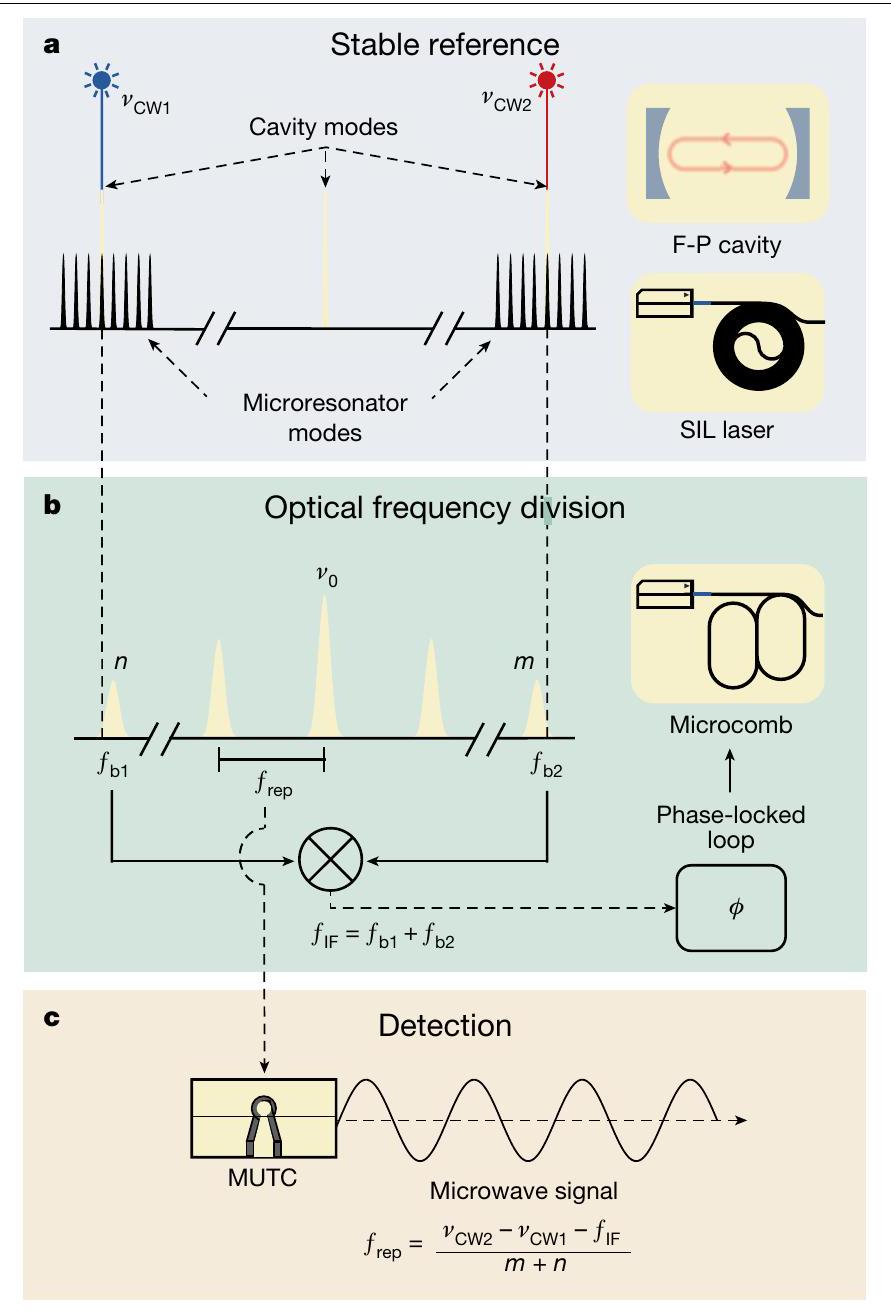
في OFD، يتم تقليل ضوضاء الطور البصري للمرجع بواسطة مربع نسبة تردده إلى تردد خرج الميكروويف. هذه وسيلة قوية لتقليل الضوضاء بعامل يصل إلى
في تكوين فرنييه
التجربة والنتائج
فراغ F-P مصغر
ليزر محجوز ذاتيًا
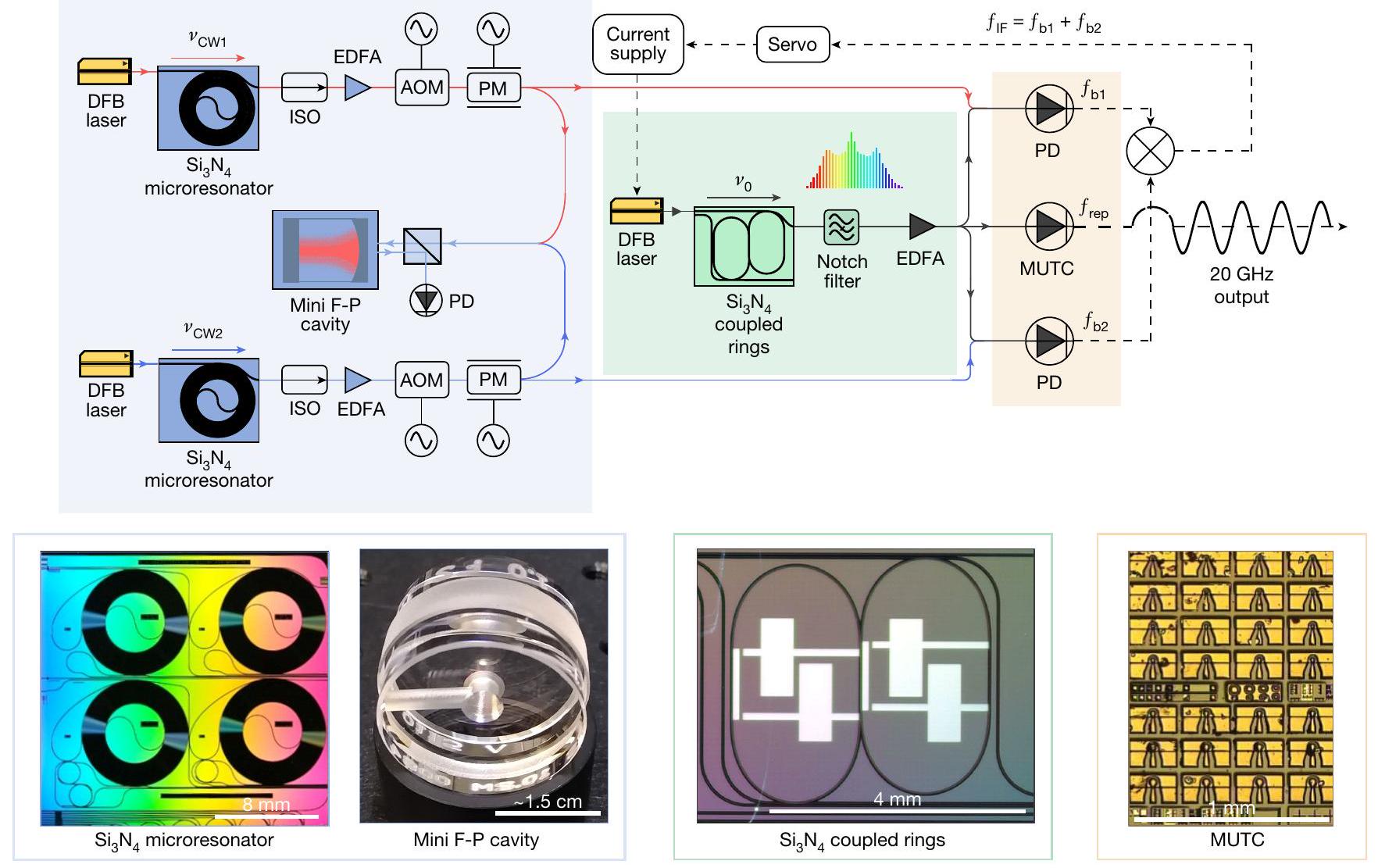
مراجع الموجة المستمرة. يتم تضخيم ملاحظتين متتاليتين، ثم يتم تصفيتهما وخلطهما معًا لإنتاج
ميكروكومب
يقلل من عرض خط الليزر المضخّم ويولد استقرارًا معقولًا
تثبيت الميكروكومب وتوليد الموجات الميكروية
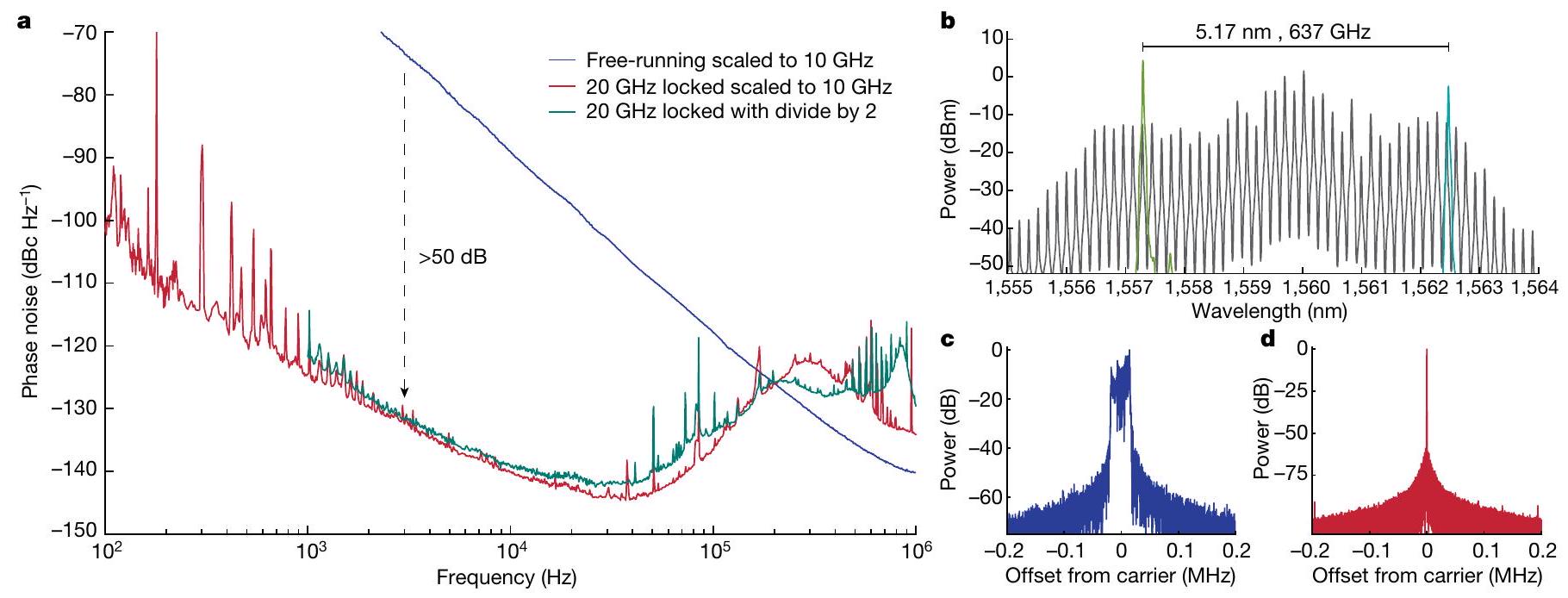
المناقشة والتكامل الإضافي
اثنان (أخضر). ب، الطيف البصري للميكروكومب (رمادي) ولازرات SIL (أخضر وزمردي). ج، د، طيف الترددات الراديوية لإشارة 20 جيجاهرتز في حالة التشغيل الحر (عرض النطاق الترددي للدقة (RBW) 100 هرتز؛ ج) ومقفل (RBW 1 هرتز؛ د).
مكونات ضوئية يمكن دمجها جميعًا على شريحة واحدة بحجم إجمالي لمكونات الضوء يبلغ تقريبًا

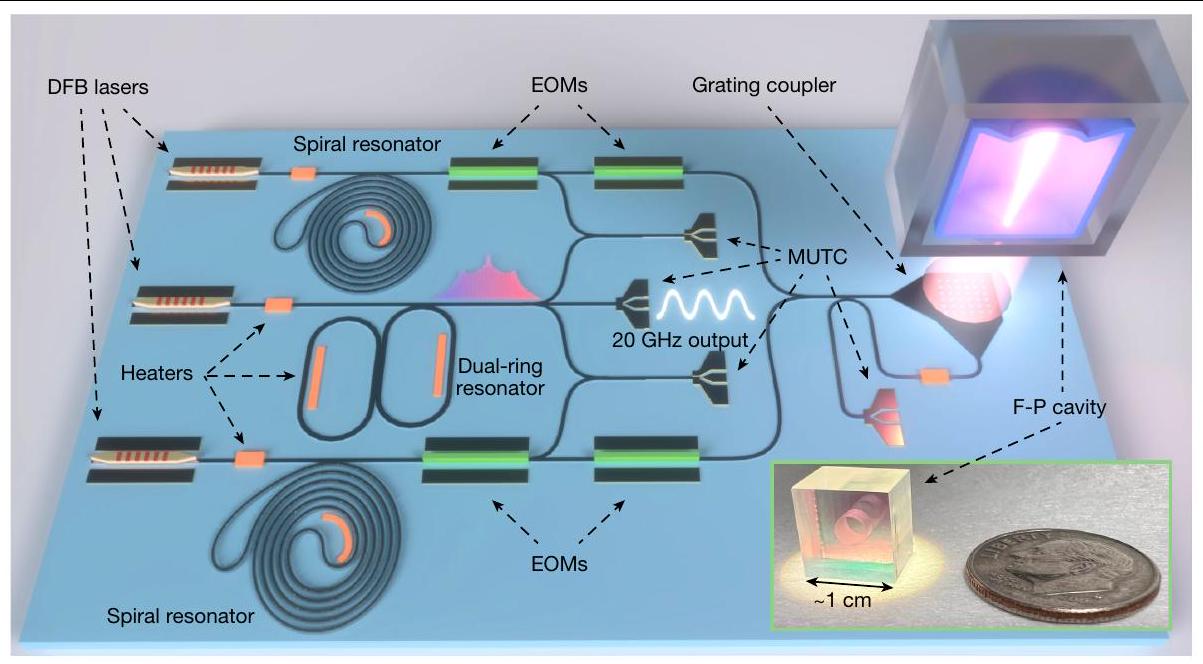
إشارة قفل PDH المنعكسة من التجويف وعزل الليزر
في الملخص، لقد أظهرنا نهجًا ضوئيًا متكاملًا لتقنية OFD ينتج إشارات ميكروويف بتردد 20 جيجاهرتز مع ضوضاء طور
المحتوى عبر الإنترنت
- فورتييه، ت. م. وآخرون. توليد ميكروويف فائقة الاستقرار عبر تقسيم التردد البصري. نات. فتون. 5، 425-429 (2011).
- ناكامورا، ت. وآخرون. تحويل الترددات الضوئية المتماسكة إلى ترددات الميكروويف مع
عدم الاستقرار. العلوم 368، 889-892 (2020). - شيا، إكس. وآخرون. إشارات ميكروويف ضوئية مع ضوضاء توقيت مطلقة بمستوى زبتوثانية. نات. فوتون. 11، 44-47 (2017).
- سوان، و. س.، باومان، إ.، جورجيتا، ف. ر. ونيو بيري، ن. ر. توليد الميكروويف مع ضوضاء طور متبقية منخفضة من ليزر ألياف فمتوثانية مع معدل تعديل كهربائي بصري داخل التجويف. أوبت. إكسبريس 19، 24387-24395 (2011).
- لي، ج.، يي، إكس.، لي، إتش.، ديدامز، س. أ. وفاهالا، ك. ج. تقسيم الترددات الكهروضوئية وتركيب الميكروويف المستقر. العلوم 345، 309-313 (2014).
- Guo، ج. وآخرون. ليزر قائم على الرقاقة مع عرض خط متكامل 1 هرتز. Sci. Adv. 8، eabp9006 (2022).
- لي، ب. وآخرون. الوصول إلى تماسك ليزر الألياف في الفوتونيات المتكاملة. رسالة أوبتيكس 46، 5201-5204 (2021).
- كيلهير، م. ل. وآخرون. تجويف بصري مضغوط ومحمول محدود بالضوضاء الحرارية مع حساسية منخفضة للتسارع. أوبت. إكسبريس 31، 11954-11965 (2023).
- جي، كيو.-إكس. وآخرون. تصميم ميكروكومبز بدون تشتت باستخدام الفوتونيات الجاهزة لتقنية CMOS. أوبتيكا 10، 279-285 (2023).
- ماتي، د. وآخرون.
ليزرات بعرض خط أقل من 10 ميجاهرتز. مجلة مراجعة الفيزياء. 118، 263202 (2017). - ديدامز، س. أ.، فاهالا، ك. وأوديم، ت. مشط الترددات البصرية: توحيد الطيف الكهرومغناطيسي بشكل متماسك. العلوم 369، eaay3676 (2020).
- كالوبوفيلاجي، م.، إندو، م. وشيبلي، ت. ر. ميكروويف ضوئي بتردد X-band مع ضوضاء طور أقل من
باستخدام مشط أحادي الكتلة يعمل بحرية. Opt. Express 30، 11266-11274 (2022). - مارتن، م. ج. ويي، ج. في الطلاءات البصرية والضوضاء الحرارية في القياسات الدقيقة (تحرير هاري، ج. م. وآخرون) 237-258 (مطبعة جامعة كامبريدج، 2012).
- جين، و. وآخرون. ليزر أشباه الموصلات بعرض خط هيرتز باستخدام ميكرو ريزوناتور عالي الجودة جاهز لتقنية CMOS. نات. فوتون. 15، 346-353 (2021).
- شيانغ، سي. وآخرون. ليزر عالي الأداء للضوئيات المتكاملة بالكامل من نيتريد السيليكون. نات. كوميون. 12، 6650 (2021).
- جين، ن. وآخرون. مرايا مصغرة مصنوعة بتقنية النانو بدقة تتجاوز مليون. أوبتيكا 9، 965-970 (2022).
- ماكليمور، سي. إيه. وآخرون. تصغير المذبذبات الكهرومغناطيسية فائقة الاستقرار: عدم استقرار التردد أقل من 10¹⁴ من خلال تجويف فابري-بيرو بحجم سنتيمتر. فيزي. ريف. أبليد. 18، 054054 (2022).
- ليو، ي. وآخرون. توليد ميكروويف منخفض الضوضاء باستخدام تجويف مرجعي بصري بفجوة هوائية. APL فوتونيكس 9، 010806 (2024).
- دريفر، ر. و. وآخرون. تثبيت الطور والتردد بالليزر باستخدام رنان بصري. فيزياء تطبيقية ب 31، 97-105 (1983).
- باب، س. ب. وآخرون. ساعة ضوئية من مشط تردد الميكرو ريزوناتور. أوبتيكا 1، 10-14 (2014).
- كوان، د.، جونغ، د.، جيون، إ.، لي، هـ. وكيم، ج. توليد ميكروويف فائق الاستقرار ونبضات سوليتون من ميكروكومب مثبت بالألياف الضوئية. نات. كوميونيك. 13، 381 (2022).
- زانغ، ج. وآخرون. تقليل تحويل السعة إلى الطور في الكاشفات الضوئية المعدلة ذات الحمل المعوض. مجلة تكنولوجيا الضوء 36، 5218-5223 (2018).
- لي، هـ. وأبراهام، ن. تحليل طيف الضوضاء لدايود الليزر مع تغذية بصرية من رنان عالي الجودة. مجلة IEEE للإلكترونيات الكمومية 25، 1782-1793 (1989).
- إندو، م. وشيبلي، ت. ر. قمع الضوضاء الطورية المتبقية لتثبيت تجويف باوند-دريفر-هال باستخدام معدل كهربائي بصري. أوسا كونتينوم 1، 116-123 (2018).
- جي، ك. وآخرون. ميكروكومب متكامل مع تشتت عادي وغير عادي قابل للتعديل. في اجتماع أوبتيكا للضوء غير الخطي 2023، سلسلة المطبوعات الفنية Tu1A-2 (مجموعة نشر أوبتيكا، 2023).
- بافلوف، ن. وآخرون. الليزر ذو العرض الضيق والميكروكومبز السوليتونية كير مع ثنائيات الليزر العادية. نات. فوتون. 12، 694-698 (2018).
- شين، ب. وآخرون. ميكروكومبز سوليتون متكاملة جاهزة. ناتشر 582، 365-369 (2020).
- بينغ، ي.، صن، ك.، شين، ي.، بيلينغ، أ. وكامبل، ج. سي. التوليد الضوئي لإشارات الميكروويف النبضية في نطاقات إكس وكيو وك. أوبت. إكسبريس 28، 28563-28572 (2020).
- شيا، إكس. وآخرون. تحسين كفاءة تحويل الطاقة في الكاشفات الضوئية عالية الأداء من خلال الربط العكسي على الماس. أوبتيكا 1، 429-435 (2014).
- Weng، و. وآخرون. تنقية طيفية لإشارات الميكروويف باستخدام سوليتونات كير المبددة المنضبطة. فيز. ريف. ليت. 122، 013902 (2019).
- لوكاس، إ. وآخرون. توليف ميكروويف فوتوني منخفض الضوضاء للغاية باستخدام مذبذب نقل قائم على مجمع السوليتون. نات. كوميونيك. 11، 374 (2020).
- ليو، ج. وآخرون. توليد الموجات الميكروية الضوئية في نطاقي x و k باستخدام ميكروكومبز السوليتون المتكاملة. نات. فوتون. 14، 486-491 (2020).
- سون، س. وآخرون. تقسيم التردد البصري المتكامل لتوليد الموجات الدقيقة والموجات المليمترية. الطبيعةhttps://doi.org/10.1038/s41586-024-07057-0 (2024).
- Yi، X. وآخرون. موجات متشتتة أحادية الوضع وديناميات ميكروكومب السوليتون. نات. كوميونيك. 8، 14869 (2017).
- يانغ، ك.-ف. وآخرون. حدود الضوضاء الناتجة عن الموجات المشتتة في مصادر الميكروويف السوليتونية الصغيرة. نات. كوميونيك. 12، 1442 (2021).
- ياو، ل. وآخرون. مذبذبات الموجات الميكروية السوليتونية باستخدام مليار ضخم
المرايا الدقيقة البصرية. أوبتيكا 9، 561-564 (2022). - تشاو، ي. وآخرون. تقسيم التردد البصري بالكامل على الرقاقة باستخدام ليزر واحد. ناتشر https:// doi.org/10.1038/s41586-024-07136-2 (2024).
- OEWaves. OE3700 Hi-Q X-band OEO. OEWaveshttps://www.oewaves.com/oe3700 (2020).
- لي، ج. وفاهالا، ك. مذبذبات ميكروويف ضوئية صغيرة الحجم ذات ضوضاء طور منخفضة للغاية في نطاقات إكس-كا. أوبتيكا 10، 33-34 (2023).
- مختبرات كوانتكس. مذبذبات ذات ضوضاء طور منخفضة للغاية. أنقى مصدر تردد. X-LNO. مذبذب ميكروويف ذو ضوضاء منخفضة للغاية. مختبرات كوانتكسhttps://www.quantxlabs.com/القدرات/تطوير المنتجات/المذبذبات ذات الضوضاء الطورية المنخفضة للغاية/(2022).
- شيانغ، سي. وآخرون. التكامل ثلاثي الأبعاد يمكّن الليزر الخالي من العوازل ذات الضوضاء المنخفضة للغاية في الفوتونيات السيليكونية. ناتشر 620، 78-85 (2023).
- شيانغ، سي. وآخرون. ميكروكومبز سوليتون بالليزر مدمجة بشكل غير متجانس على السيليكون. ساينس 373، 99-103 (2021).
- شيا، و. وآخرون. استشعار الفوتونيات السيليكونية غير المتجانسة للسيارات الذاتية القيادة. أوبت. إكسبريس 27، 3642-3663 (2019).
- إدجادي، م. هـ. وأفلاتوني، ف. نظام تثبيت ليزر باوند-دريفر-هال المتكامل في السيليكون. نات. كوميونيك. 8، 1209 (2017).
- تشنغ، هـ. وآخرون. نهج جديد لربط رنانات فابري-بروت عالية الجودة مع الدوائر الضوئية. APL Photon. 8، 116105 (2023).
- ليو، ج. وآخرون. التحكم الكهروضغطي الأحادي في ميكروكومب السوليتون. الطبيعة 583، 385-390 (2020).
- جوشي، سي. وآخرون. توليد المشط تحت التحكم الحراري ونمذجة السوليتون في الميكرو ريزوناتورز. رسالة أوبتيك. 41، 2565-2568 (2016).
- ديدامز، س. أ. وآخرون. ساعة ضوئية تعتمد على حبس مفرد
أيون. العلوم 293، 825-828 (2001). - فورتييه، ت. وآخرون. جهاز توليد إلكتروني عريض النطاق مرجعي بصريًا بدقة 15 رقم. مراجعة ليزر وفوتون. 10، 780-790 (2016).
- يي، إكس.، يانغ، كيو-إف.، يانغ، كاي. واي.، سوه، م.-جي. وفاهالا، ك. مجموعة ترددات السوليتون بمعدلات الميكروويف في رنان ميكروي من السيليكا عالي الجودة. أوبتيكا 2، 1078-1085 (2015).
- لي، ج.، لي، هـ.، تشين، ت. وفاهالا، ك. ج. تشغيل معدل التكرار في الميكروكومبز بقوة مضخة منخفضة، وضوضاء طور منخفضة، ومن الميكروويف إلى الموجات المليمترية. فيز. ريف. ليت. 109، 233901 (2012).
- ليانغ، و. وآخرون. مذبذب فوتوني بتردد كير عالي النقاء الطيفي. نات. كوم. 6، 7957 (2015).
- ماتسكو، أ. وآخرون. تشغيل جاهز واستقرار أطياف كير. في ندوة التحكم في التردد الدولية IEEE لعام 2016 (IFCS) 1-5 (IEEE، 2016).
(ج) المؤلف(ون) 2024
طرق
توصيف مساهمات الضوضاء في ضوضاء الميكروويف
عند الترددات التي تقل عن 1 كيلوهرتز، تكون ضوضاء الطور لإشارة 20 جيجاهرتز محدودة بضوضاء الإلكترونيات لقفل PDH، والتي يمكن تحسينها عن طريق زيادة تقليل ضوضاء الطور 2P-OFD (أي، باستخدام ميكروكومب بعرض نطاق أوسع). عند الترددات التي تزيد عن عدة عشرات من الكيلوهرتز، تزداد ضوضاء الطور بسبب الكسب المحدود وعرض النطاق لحلقة التغذية الراجعة للميكروكومب. تتبع ضوضاء الطور لإشارة 20 جيجاهرتز عند الترددات التي تزيد عن 1 ميغاهرتز ضوضاء الطور للإشارة الحرة، والتي يمكن العثور عليها في المرجع 9. يمكن تقليل الضوضاء عالية التردد باستخدام حالة ميكروكومب حرة أكثر استقرارًا أو عن طريق تحسين عرض نطاق التغذية الراجعة. كما يمكن ملاحظته، في النطاق بين 1 و40 كيلوهرتز، لا تؤثر مساهمات الضوضاء المدرجة على توليد الميكروويف، والذي ينخفض كما
الإلكترونيات لتثبيت الميكروكومب وقياس ضوضاء الطور
توضح البيانات الموسعة الشكل 2b الإعداد التجريبي لقياس ضوضاء الطور لإشارة 20 جيجاهرتز. لقياس ضوضاء الطور للميكروكومب، استخدمنا الميكروويف الفائق الاستقرار من مزيج تردد Er:fibre المرجعي الذاتي
إنتاج إشارتين عند 47 ميغاهرتز. يتم استخدام ذراعين للتداخل المتقاطع لإزالة الضوضاء الإضافية من مضخمات الميكروويف في الفرع المرجعي. تم تحقيق التداخل المتقاطع باستخدام محلل ضوضاء الطور التجاري.
تقسيم تجديدي بمقدار اثنين
متطلبات الطاقة الضوئية للنظام المتكامل
فراغ مع مرايا مصغرة مصنوعة بتقنية النانو
توفر البيانات
54. شميت، ف.، ويتنبرغ، ج.، هانش، ت. و.، أوديم، ت. وأوزاوا، أ. مخطط بسيط لقياس ضوضاء الطور لأنظمة الليزر المستقرة في التجاويف. رسائل أوبتيك. 44، 2709-2712 (2019).
55. هاتي، أ. وآخرون. مقسم تردد متجدد ذو ضوضاء منخفضة للغاية. مجلة IEEE للالتراسونيك والفيروإلكتريك والتحكم في التردد 59، 2596-2598 (2012).
56. زعوي، و. س.، كونز، أ.، فوجل، و. و بيروث، م. موصلات شق التقطيع القطبي المتوافقة مع CMOS مع مرآة معدنية خلفية. رسالة تكنولوجيا الفوتونيات IEEE 25، 1395-1397 (2013).
معلومات إضافية
يجب توجيه المراسلات والطلبات للحصول على المواد إلى إيغور كوديلين أو سكوت أ. ديدامز.
معلومات مراجعة الأقران تشكر مجلة Nature المراجعين المجهولين على مساهمتهم في مراجعة هذا العمل. تقارير مراجعي الأقران متاحة.
معلومات إعادة الطبع والتصاريح متاحة علىhttp://www.nature.com/reprints.
مقالة
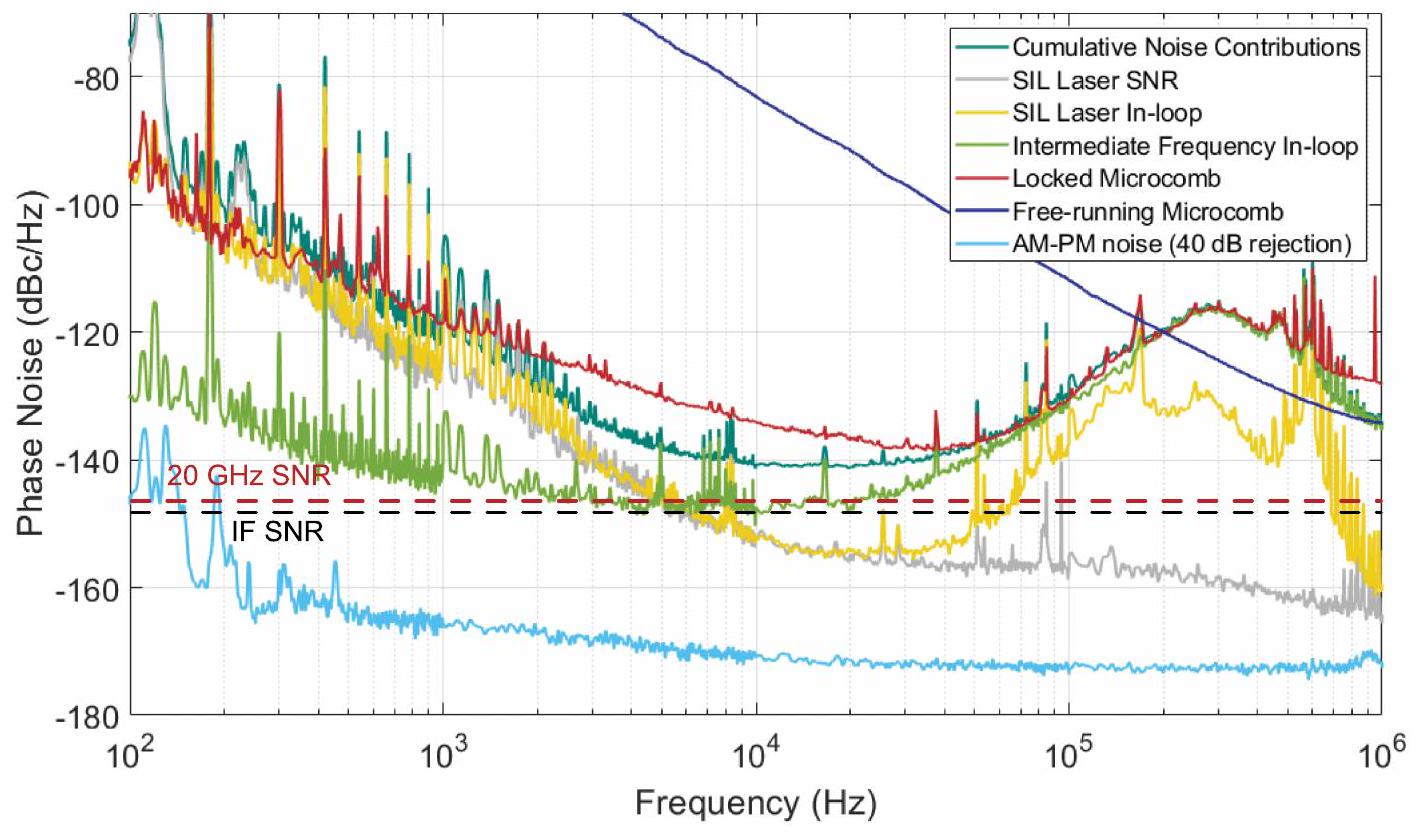
يمثل الضجيج التراكمي مجموع المربعات لجميع مصطلحات الضجيج المعروضة.
يتم عرض ضوضاء الليزر داخل الحلقة فقط لليزر SIL واحد، حيث أن ضوضاء كلا من SIL
الليزر هو نفسه. الخط المنقط الأحمر (الأسود) يوضح حدود نسبة الإشارة إلى الضوضاء (SNR) لتردد الميكروويف 20 جيجاهرتز (التردد الوسيط).
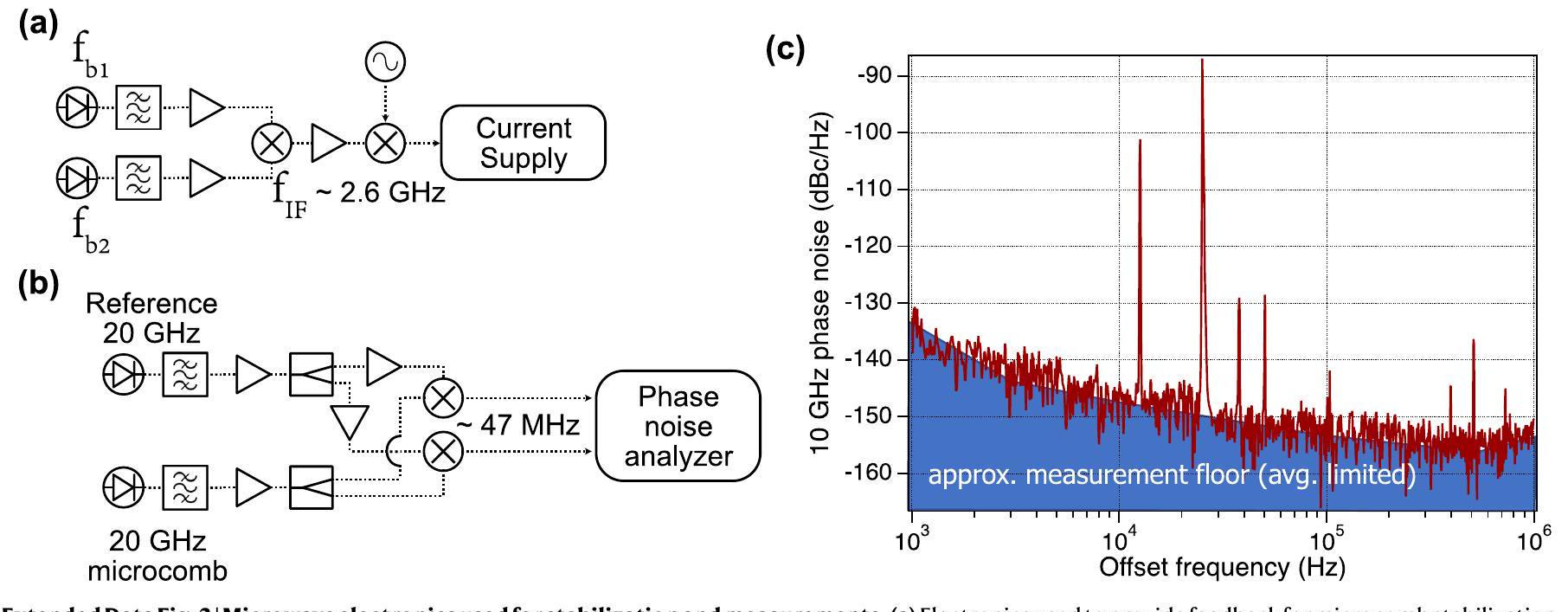
(ب) إعداد قياس ضوضاء الطور لإشارة ميكروويف بتردد 20 جيجاهرتز. (ج) ضوضاء الطور لإشارة 20 جيجاهرتز المرجعية المستخدمة في الارتباط المتقاطع.
مقالة
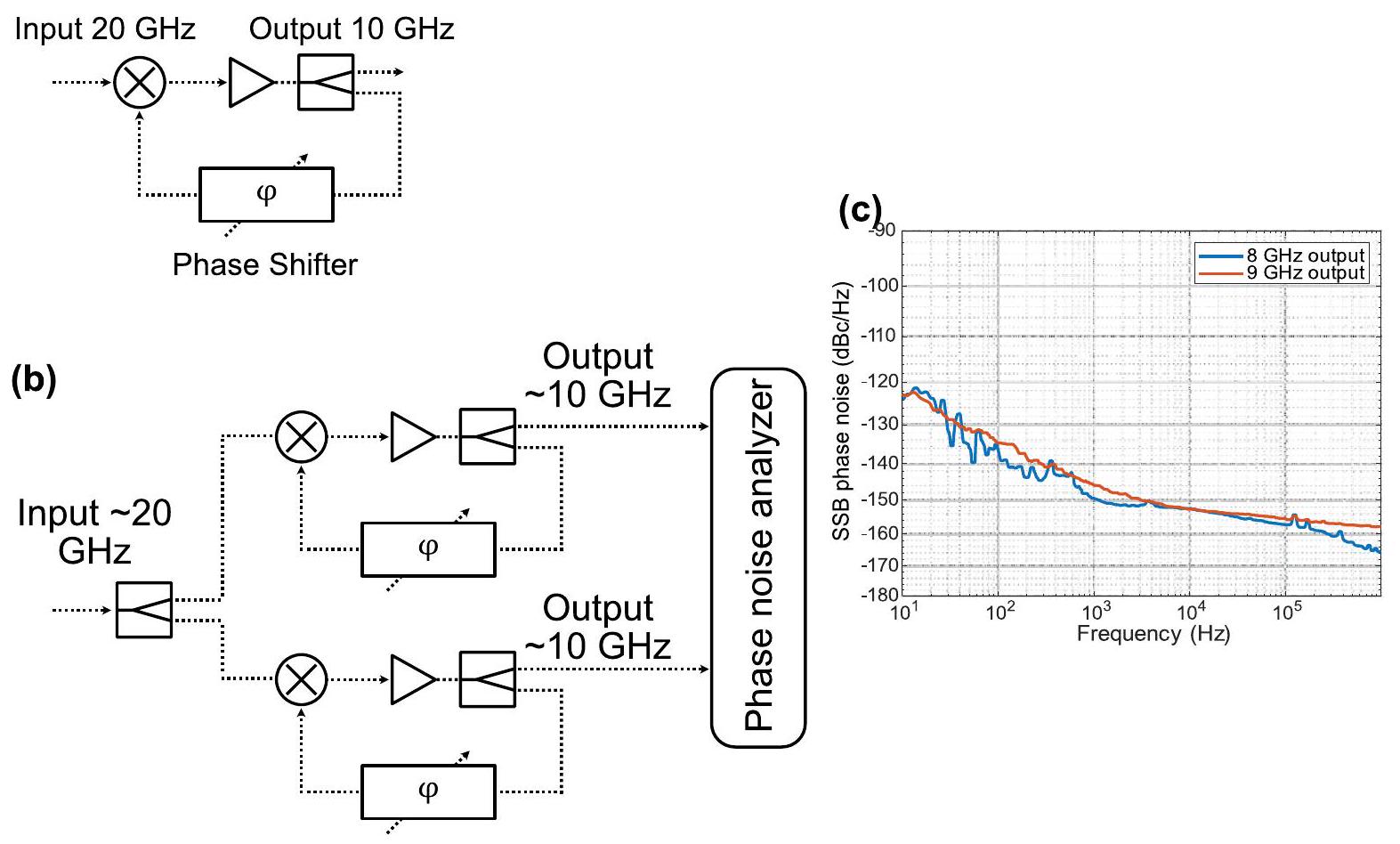
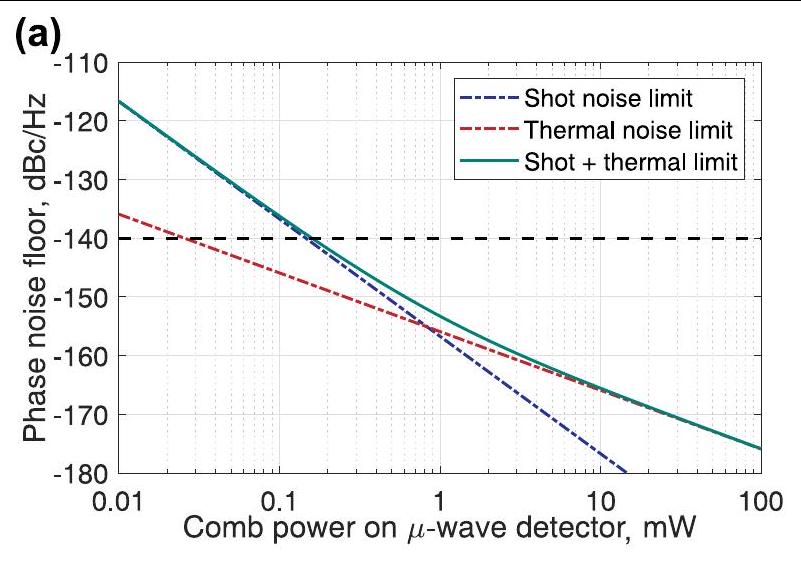
(ب)

يمثل الخط المنقط الأداء المطلوب لتحقيق النتائج المعروضة في الورقة. تفترض الحسابات كفاءة كوانتوم للكاشف الضوئي تبلغ 0.5.
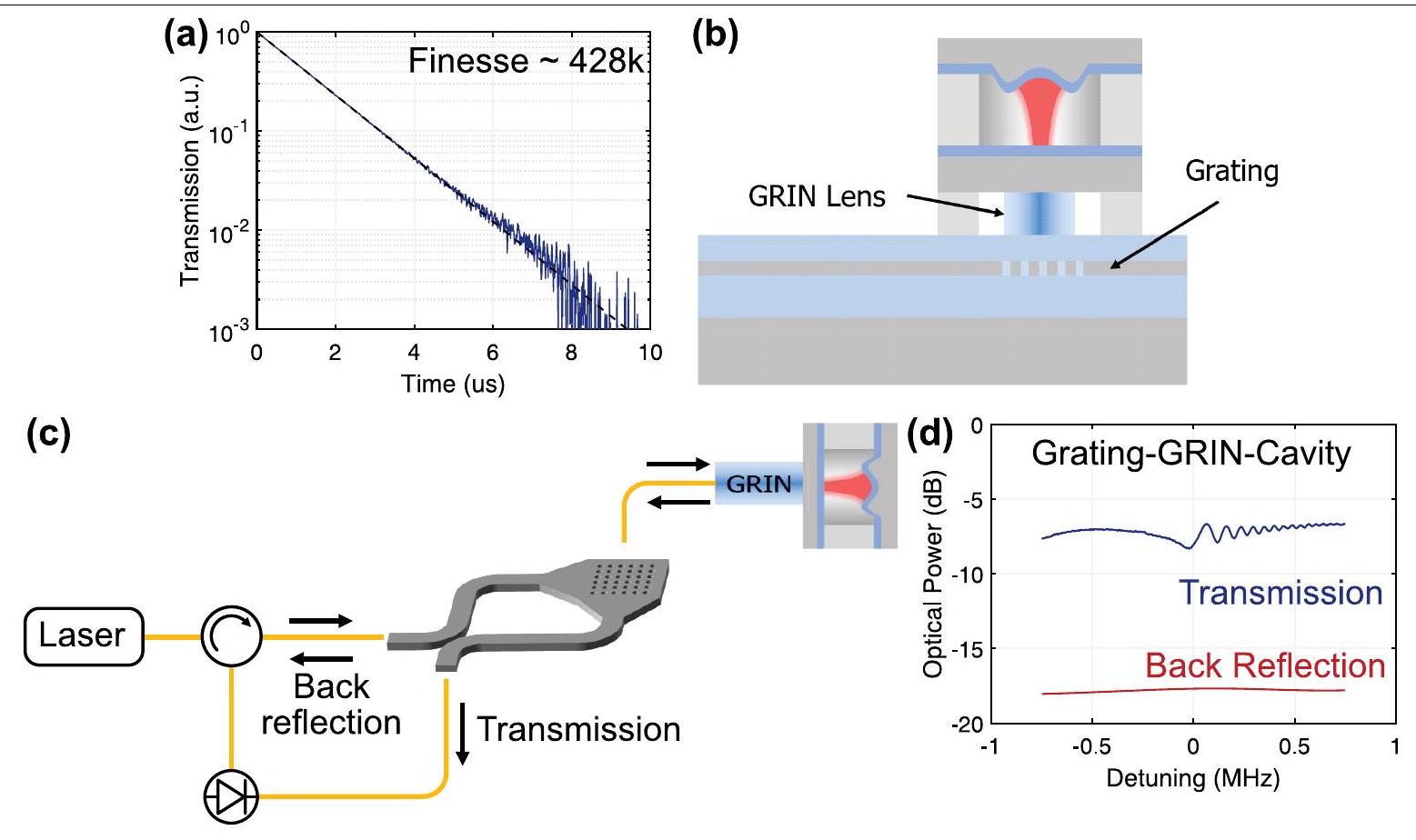
DOI: https://doi.org/10.1038/s41586-024-07058-z
PMID: https://pubmed.ncbi.nlm.nih.gov/38448599
Publication Date: 2024-03-06
Photonic chip-based low-noise microwave oscillator
Received: 21 July 2023
Accepted: 11 January 2024
Published online: 6 March 2024
Open access
(A) Check for updates
Abstract
Numerous modern technologies are reliant on the low-phase noise and exquisite timing stability of microwave signals. Substantial progress has been made in the field of microwave photonics, whereby low-noise microwave signals are generated by the down-conversion of ultrastable optical references using a frequency comb

In OFD, the optical phase noise of the reference is then reduced by the square of the ratio of its frequency to that of the microwave output. This is a powerful means for noise reduction by a factor as large as
in a Vernier configuration
Experiment and results
Miniature F-P cavity
Self-injection-locked lasers

continuous wave references. Two beat notes are amplified, filtered and then mixed together to produce
Microcomb
narrows the linewidth of the pump laser and generates a reasonably stable
Microcomb stabilization and microwave generation

Discussion and further integration
two (green). b, Optical spectrum of microcomb (grey) and SIL lasers (green and turquoise).c,d, Radio frequency spectra of 20 GHz signal free running (resolution bandwidth (RBW) 100 Hz ; c) and locked (RBW1 Hz; d).
photonic components that can all be further combined onto a single chip with total volume of the photonic components of approximately


cavity-reflected PDH locking signal and laser isolation
In summary, we have demonstrated an integrated photonic approach to OFD that produces 20 GHz microwave signals with phase noise of
Online content
- Fortier, T. M. et al. Generation of ultrastable microwaves via optical frequency division. Nat. Photon. 5, 425-429 (2011).
- Nakamura, T. et al. Coherent optical clock down-conversion for microwave frequencies with
instability. Science 368, 889-892 (2020). - Xie, X. et al. Photonic microwave signals with zeptosecond-level absolute timing noise. Nat. Photon. 11, 44-47 (2017).
- Swann, W. C., Baumann, E., Giorgetta, F. R. & Newbury, N. R. Microwave generation with low residual phase noise from a femtosecond fiber laser with an intracavity electro-optic modulator. Opt. Express 19, 24387-24395 (2011).
- Li, J., Yi, X., Lee, H., Diddams, S. A. & Vahala, K. J. Electro-optical frequency division and stable microwave synthesis. Science 345, 309-313 (2014).
- Guo, J. et al. Chip-based laser with 1-hertz integrated linewidth. Sci. Adv. 8, eabp9006 (2022).
- Li, B. et al. Reaching fiber-laser coherence in integrated photonics. Opt. Lett. 46, 5201-5204 (2021).
- Kelleher, M. L. et al. Compact, portable, thermal-noise-limited optical cavity with low acceleration sensitivity. Opt. Express 31, 11954-11965 (2023).
- Ji, Q.-X. et al. Engineered zero-dispersion microcombs using CMOS-ready photonics. Optica 10, 279-285 (2023).
- Matei, D. et al.
lasers with sub- 10 mHz linewidth. Phys. Rev. Lett. 118, 263202 (2017). - Diddams, S. A., Vahala, K. & Udem, T. Optical frequency combs: coherently uniting the electromagnetic spectrum. Science 369, eaay3676 (2020).
- Kalubovilage, M., Endo, M. & Schibli, T. R. X-band photonic microwaves with phase noise below
using a free-running monolithic comb. Opt. Express 30, 11266-11274 (2022). - Martin, M. J. and Ye, J. in Optical Coatings and Thermal Noise in Precision Measurement (eds Harry, G. M. et al.) 237-258 (Cambridge Univ. Press, 2012).
- Jin, W. et al. Hertz-linewidth semiconductor lasers using CMOS-ready ultra-high-Q microresonators. Nat. Photon. 15, 346-353 (2021).
- Xiang, C. et al. High-performance lasers for fully integrated silicon nitride photonics. Nat. Commun. 12, 6650 (2021).
- Jin, N. et al. Micro-fabricated mirrors with finesse exceeding one million. Optica 9, 965-970 (2022).
- McLemore, C. A. et al. Miniaturizing ultrastable electromagnetic oscillators: sub-10¹4 frequency instability from a centimeter-scale Fabry-Perot cavity. Phys. Rev. Appl. 18, 054054 (2022).
- Liu, Y. et al. Low noise microwave generation with an air-gap optical reference cavity. APL Photonics 9, 010806 (2024).
- Drever, R. W. et al. Laser phase and frequency stabilization using an optical resonator. Appl. Phys. B 31, 97-105 (1983).
- Papp, S. B. et al. Microresonator frequency comb optical clock. Optica 1, 10-14 (2014).
- Kwon, D., Jeong, D., Jeon, I., Lee, H. & Kim, J. Ultrastable microwave and soliton-pulse generation from fibre-photonic-stabilized microcombs. Nat. Commun. 13, 381 (2022).
- Zang, J. et al. Reduction of amplitude-to-phase conversion in charge-compensated modified unitraveling carrier photodiodes. J. Lightwave Tech. 36, 5218-5223 (2018).
- Li, H. & Abraham, N. Analysis of the noise spectra of a laser diode with optical feedback from a high-finesse resonator. IEEE J. Quantum Electron. 25, 1782-1793 (1989).
- Endo, M. & Schibli, T. R. Residual phase noise suppression for Pound-Drever-Hall cavity stabilization with an electro-optic modulator. OSA Continuum 1, 116-123 (2018).
- Ji, Q. et al. Integrated microcomb with broadband tunable normal and anomalous dispersion. In Optica Nonlinear Optics Topical Meeting 2023, Technical Digest Series Tu1A-2 (Optica Publishing Group, 2023).
- Pavlov, N. et al. Narrow-linewidth lasing and soliton kerr microcombs with ordinary laser diodes. Nat. Photon. 12, 694-698 (2018).
- Shen, B. et al. Integrated turnkey soliton microcombs. Nature 582, 365-369 (2020).
- Peng, Y., Sun, K., Shen, Y., Beling, A. & Campbell, J. C. Photonic generation of pulsed microwave signals in the x-, ku-and k-band. Opt. Express 28, 28563-28572 (2020).
- Xie, X. et al. Improved power conversion efficiency in high-performance photodiodes by flip-chip bonding on diamond. Optica 1, 429-435 (2014).
- Weng, W. et al. Spectral purification of microwave signals with disciplined dissipative Kerr solitons. Phys. Rev. Lett. 122, 013902 (2019).
- Lucas, E. et al. Ultralow-noise photonic microwave synthesis using a soliton microcombbased transfer oscillator. Nat. Commun. 11, 374 (2020).
- Liu, J. et al. Photonic microwave generation in the x -and k -band using integrated soliton microcombs. Nat. Photon. 14, 486-491 (2020).
- Sun, S. et al. Integrated optical frequency division for microwave and mmWave generation. Nature https://doi.org/10.1038/s41586-024-07057-0 (2024).
- Yi, X. et al. Single-mode dispersive waves and soliton microcomb dynamics. Nat. Commun. 8, 14869 (2017).
- Yang, Q.-F. et al. Dispersive-wave induced noise limits in miniature soliton microwave sources. Nat. Commun. 12, 1442 (2021).
- Yao, L. et al. Soliton microwave oscillators using oversized billion
optical microresonators. Optica 9, 561-564 (2022). - Zhao, Y. et al. All-optical frequency division on-chip using a single laser. Nature https:// doi.org/10.1038/s41586-024-07136-2 (2024).
- OEWaves. OE3700 Hi-Q X-band OEO. OEWaves https://www.oewaves.com/oe3700 (2020).
- Li, J. & Vahala, K. Small-sized, ultra-low phase noise photonic microwave oscillators at x-ka bands. Optica 10, 33-34 (2023).
- Quantx Labs. Ultra-low phase noise oscillators. The purest frequency source. X-LNO. Ultra-low-noise microwave oscillator. Quantx Labs https://www.quantxlabs.com/ capabilities/product-development/ultra-low-phase-noise-oscillators/(2022).
- Xiang, C. et al. 3D integration enables ultralow-noise isolator-free lasers in silicon photonics. Nature 620, 78-85 (2023).
- Xiang, C. et al. Laser soliton microcombs heterogeneously integrated on silicon. Science 373, 99-103 (2021).
- Xie, W. et al. Heterogeneous silicon photonics sensing for autonomous cars. Opt. Express 27, 3642-3663 (2019).
- Idjadi, M. H. & Aflatouni, F. Integrated Pound-Drever-Hall laser stabilization system in silicon. Nat. Commun. 8, 1209 (2017).
- Cheng, H. et al. A novel approach to interface high-Q Fabry-Perot resonators with photonic circuits. APL Photon. 8, 116105 (2023).
- Liu, J. et al. Monolithic piezoelectric control of soliton microcombs. Nature 583, 385-390 (2020).
- Joshi, C. et al. Thermally controlled comb generation and soliton modelocking in microresonators. Opt. Lett. 41, 2565-2568 (2016).
- Diddams, S. A. et al. An optical clock based on a single trapped
ion. Science 293, 825-828 (2001). - Fortier, T. et al. Optically referenced broadband electronic synthesizer with 15 digits of resolution. Laser Photon. Rev. 10, 780-790 (2016).
- Yi, X., Yang, Q.-F., Yang, K. Y., Suh, M.-G. & Vahala, K. Soliton frequency comb at microwave rates in a high-Q silica microresonator. Optica 2, 1078-1085 (2015).
- Li, J., Lee, H., Chen, T. & Vahala, K. J. Low-pump-power, low-phase-noise, and microwave to millimeter-wave repetition rate operation in microcombs. Phys. Rev. Lett. 109, 233901 (2012).
- Liang, W. et al. High spectral purity Kerr frequency comb radio frequency photonic oscillator. Nat. Commun. 6, 7957 (2015).
- Matsko, A. et al. Turn-key operation and stabilization of Kerr frequency combs. In 2016 IEEE International Frequency Control Symposium (IFCS) 1-5 (IEEE, 2016).
(c) The Author(s) 2024
Methods
Characterization of the noise contributions to the microwave noise
At frequencies below 1 kHz , the phase noise of the 20 GHz signal is limited by the electronic noise of the PDH locks, which could be improved by increasing the 2P-OFD phase noise reduction (that is, by using a microcomb with broader bandwidth). At frequencies above several tens of kilohertz, the phase noise increases because of the limited gain and bandwidth of the microcomb feedback loop. The phase noise of the 20 GHz signal at frequencies above 1 MHz follows the phase noise of the free-running signal, which can be found in ref. 9. High-frequency noise could be decreased by using a more stable free-running microcomb state or by improving the feedback bandwidth. As can be seen, in the range between 1 and 40 kHz , the listed noise contributions do not affect the microwave generation, which decreases as
Electronics for microcomb stabilization and phase noise measurement
Extended Data Fig. 2b illustrates the experimental setup for measuring phase noise of the 20 GHz signal. To measure the phase noise of the microcomb, we used the ultrastable microwave from a self-referenced Er:fibre frequency comb
produce two signals at 47 MHz . Two arms are used for cross correlation to remove the additional noise from the microwave amplifiers in the reference branch. The cross correlation was realized with a commercial phase noise analyzer.
Regenerative divide by two
Optical power requirements for the integrated system
Cavity with microfabricated mirrors
Data availability
54. Schmid, F., Weitenberg, J., Hänsch, T. W., Udem, T. & Ozawa, A. Simple phase noise measurement scheme for cavity-stabilized laser systems. Opt. Lett. 44, 2709-2712 (2019).
55. Hati, A. et al. Ultra-low-noise regenerative frequency divider. IEEE Trans. Ultrasonics Ferroelectrics Freq. Control 59, 2596-2598 (2012).
56. Zaoui, W. S., Kunze, A., Vogel, W. & Berroth, M. CMOS-compatible polarization splitting grating couplers with a backside metal mirror. IEEE Photon. Tech. Lett. 25, 1395-1397 (2013).
Additional information
Correspondence and requests for materials should be addressed to Igor Kudelin or Scott A. Diddams.
Peer review information Nature thanks the anonymous reviewers for their contribution to the peer review of this work. Peer reviewer reports are available.
Reprints and permissions information is available at http://www.nature.com/reprints.
Article

Cumulative noise represents the quadrature sum of all the shown noise terms.
In-loop laser noise is shown only for a single SIL laser, since the noise of both SIL
lasers are the same. Red (black) dotted line shows SNR limits of the 20 GHz microwave (intermediate frequency).

(b) Phase noise measurement setup of 20 GHz microwave signal. (c) Phase noise of the reference 20 GHz signal used for cross correlation.
Article


(b)

dotted line represents the required performance to achieve the results presented in the paper. The calculations assume a photodetector quantum efficiency of 0.5 .

